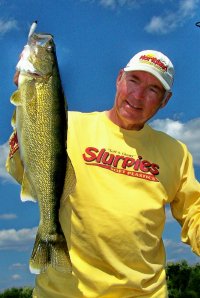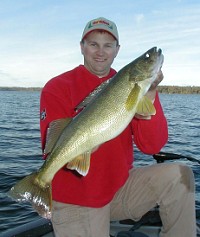 Spring and early summer can produce some of the best walleye fishing of the season both jiggin’ and riggin’. Post-spawn fish are quick to recover and begin feeding in northern latitudes, as the growing season is short.
Spring and early summer can produce some of the best walleye fishing of the season both jiggin’ and riggin’. Post-spawn fish are quick to recover and begin feeding in northern latitudes, as the growing season is short.
Two primary presentations are used to catch early-season walleyes . . . jigs and rigs. Sure, casting minnow imitating crankbaits at night and using a slip-bobber set-up on an isolated spot are presentations that should not be ignored. However, jigs and live-bait rigs are the norm during this time period.
Personally, I seldom use anything but a 1/16 ounce Fire-Ball Jig and shiner minnow through the month of June. Minnows have proven to be the preferred form of live bait for walleyes when the water temperature is on the cooler end of the spectrum. A jig basically works as a weight to get a minnow or other bait down near the bottom. Choosing the most effective weight is fairly simple. Use the lightest jig that will stay near the bottom despite factors such as depth and wind. Post-spawn walleyes generally remain in relatively shallow water. So, I start with a 1/16-ounce jig. If the wind increases, I will adjust to a 1/8-ounce jig. Rarely do I go above 1/8 ounce unless I’m fishing deeper than fifteen feet or in current, where a 1/4 or 3/8 ounce version is employed.
Regarding color, chartreuse is arguably the most popular color walleye jig. I like to mix it up a little but always have a bit of chartreuse or lime green on the jig, regardless of water clarity. My favorite color Fire-Ball® Jigs are fire-tiger, parrot, watermelon, super-glo chartreuse, and super-glo green.
During the first few weeks of the season, I like to add a Sting’r Hook to my jig. Fish can be sluggish in cold water and tend to bite short. When using larger shiners, I use a three-inch stinger. For smaller shiners and fatheads, I drop to a two-inch stinger hook. Make note of the number of fish hooked on the stinger only. Only then does one realize how many bites would be missed without it.
A 6’6” medium-action St. Croix Avid spinning rod paired with a quality spinning reel gets the call when jigging. Six-pound test Berkley Vanish fluorocarbon is my line of choice.
While walleyes are shallow, say in less than fifteen feet of water, a casting approach is effective. Pitching away from the boat avoids spooking fish. A good breeze and some cloud cover may facilitate a drifting approach. Regardless, a lift-and-fall action works best. Fish will generally take the jig and minnow offering on the fall and can be detected by a subtle bump. Otherwise, weight is felt on the next lift. In either case, set the hook immediately.
Leeches and nightcrawlers become effective at fooling walleyes as the heat of summer warms the water. A live-bait rig such as a Roach Rig is the most popular way to present a leech or crawler. Live-bait rigs have come a long way since the plain hook and lead weight. For example, painted hooks and sinkers are popular. Floats can be added to cause the bait to rise higher off the bottom. Beads can add color to the presentation. Snell lengths are easily adjusted without retying. Weights are easily attached and detached without retying as well.
As the water warms, I will have a Roach Rig tied up on each walleye outing. For starters, I will try a leech impaled on a #4 fish hook. Historically, I have used a ¼ ounce Roach Walker Sinker, chartreuse in color. However, in weedy terrain, the Sling-Shot® Worm Weight is dynamite. In rocky areas, a Rock-Runner® Slip Bouncer is put to work. Again, I’ll increase the weight as dictated by the depth and wind. It’s imperative to remain in contact with the bottom at all times. I like to use a snell that is 6-8 feet in length. I’ll experiment with crawlers as well but like to drop down to a #6 hook with them. I’ll replace the hook with a Gum Drop® Floater when fish appear to be suspended a few feet off the bottom.
Many “riggers” lean toward longer spinning combos, myself included. A 7’ medium/light fast action St. Croix Avid paired with an ABU Garcia Cardinal 502 spinning reel fits the bill for me. Again, six-pound Vanish gets the job done.
Drifting and backtrolling are  employed when fishing live-bait rigs. Seldom does the wind move the boat in exactly the right direction. Therefore, for precision in following breaklines and the edge of the structure, I prefer to use a “controlled drift.” Using the wind to move the boat as much as possible, the electric or outboard motor is kicked in and out of gear to maintain the course.
employed when fishing live-bait rigs. Seldom does the wind move the boat in exactly the right direction. Therefore, for precision in following breaklines and the edge of the structure, I prefer to use a “controlled drift.” Using the wind to move the boat as much as possible, the electric or outboard motor is kicked in and out of gear to maintain the course.
With the bail of the reel open and the line run over my index finger, I’ll drop the line at the slightest hint of a bite and feed the fish line for upwards of ten seconds. Some fish will remain still after inhaling a meal. Others, especially those that are in a school and competing for food, will quickly swim away, peeling line from the reel. Take up the slack and set the hook.
While jigs and minnows are the ticket to walleyes during the early season, they shouldn’t be overlooked once the water warms up a bit. They are effective when used with crawlers and leeches as well. As we transition from early to mid-summer however, leeches and crawlers are walleye delicacies, best presented with a live-bait rig. Keep a jig and a rig ready and you’re on your way to a walleye-filled live-well.
Jigs and rigs coupled with live bait remain bread and butter presentations for walleyes.

